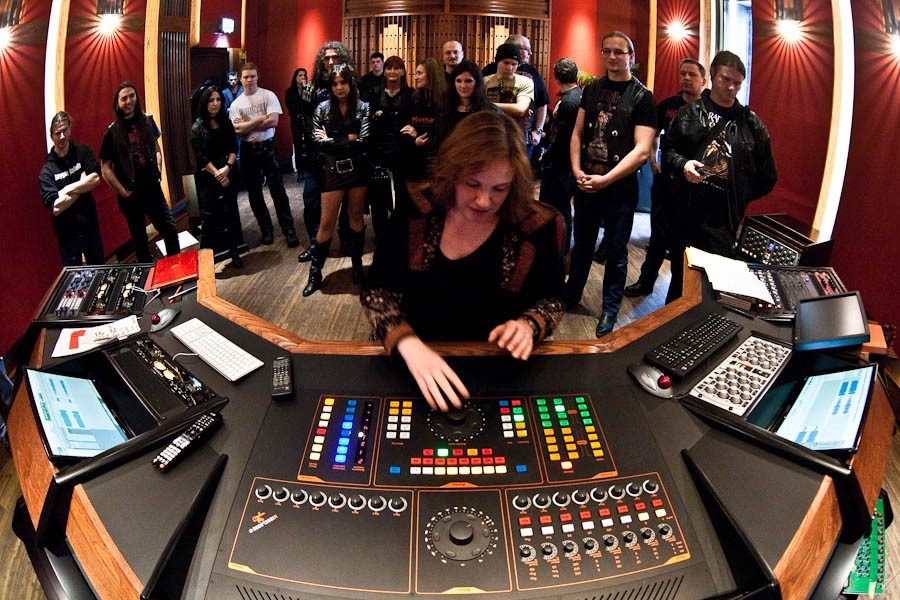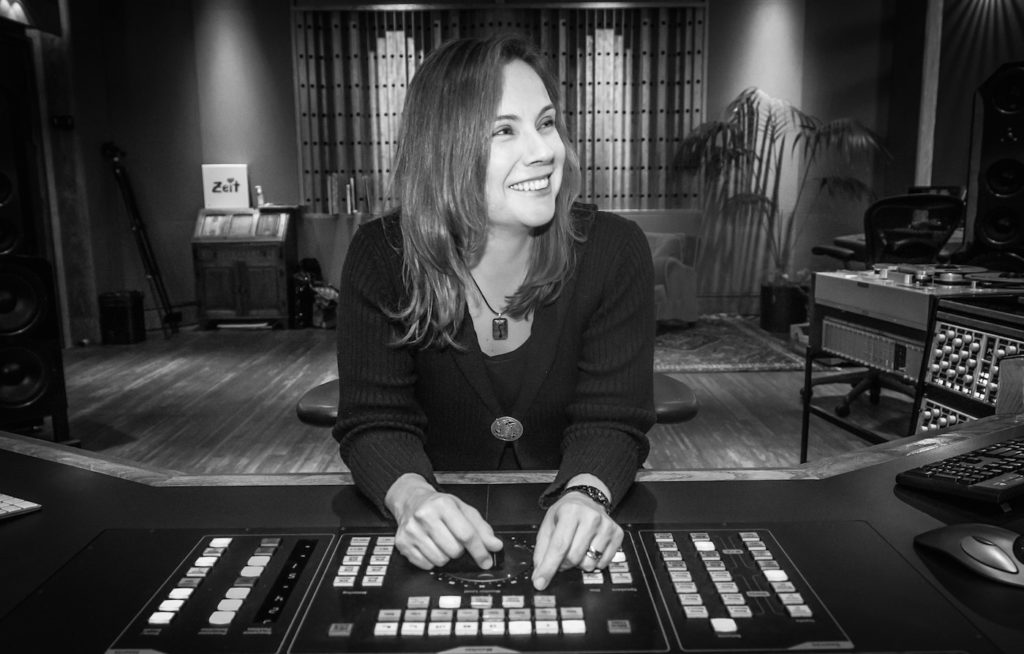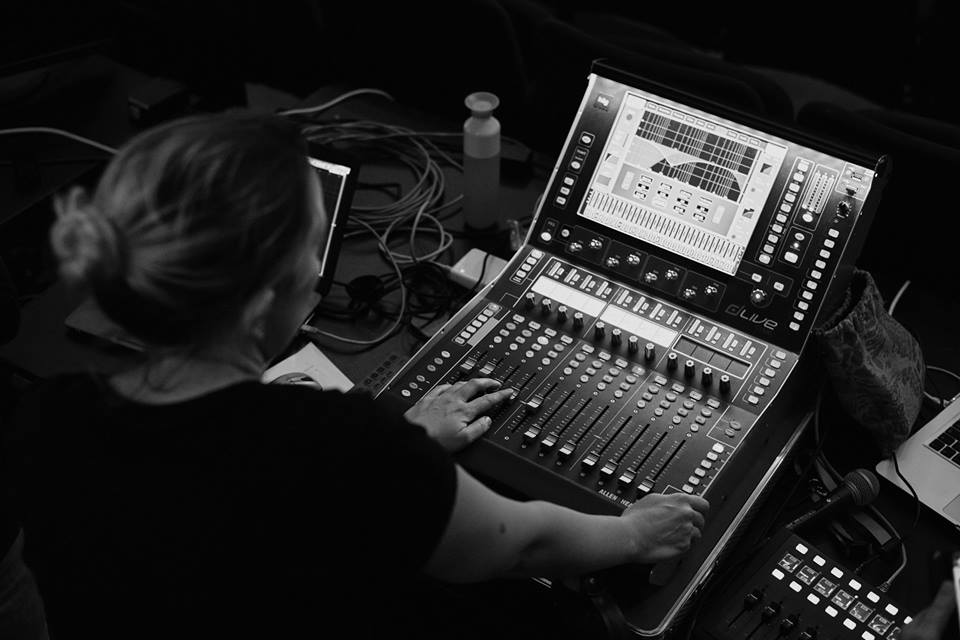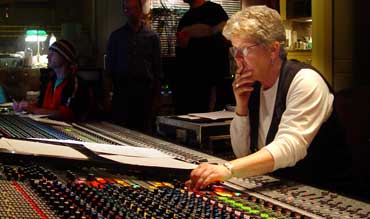Darcy Proper became the first woman engineer to win the GRAMMY for the Best Surround Sound Album category in 2008 for Donald Fagen’s “Morph the Cat” album. Darcy not only achieved these despite being a minority in her field, but she also accomplished these while she lived thousands of miles away from the center of the American music scene. Unlike many engineers based in New York or Hollywood, Darcy Proper’s mastering headquarters was located in Belgium and The Netherlands for three of her four Grammy wins. She has just recently returned to the U.S. and is currently based in central New York.
Studies have shown that there are less than 10% of women working in the audio engineering field. With the world of sound encompassing a vastly wide array of disciplines, this could range from working in a commercial studio as a recording engineer, doing post-production for film/TV, to touring with artists as a live sound reinforcement engineer, among others. Not often discussed, however, is this small specialized field called Mastering.
Working within the confines of an acoustically precise studio, fitted with top-of-the-line monitoring speakers ranging from stereo to a 5.1 surround setup (or more), mastering engineers are responsible for the final crucial step in the audio post-production process. Often considered an elusive discipline, mastering is distinctly nuanced in both the technical and creative aspect of sound. With this–coupled with the low women-in-audio statistic–one can say that women in mastering may be deemed as unicorns–a rarity in an already male-dominated career path.
This, however, did not prevent mastering engineer Darcy Proper from winning multiple GRAMMY awards in various engineering categories (3 wins & 9 nominations to be exact). Most notably, Darcy Proper became the first female engineer to win the GRAMMY for the Best Surround Sound Album category in 2008 for Donald Fagen’s “Morph the Cat” album. Darcy not only achieved these despite being a minority in her field, she accomplished these while she lived thousands of miles away from the center of the American music scene. Unlike many engineers who are based in New York or Hollywood, Darcy Proper’s current mastering headquarters is located in the Netherlands at Wisseloord Studios.
One may ask how Darcy Proper ever got into the world of mastering in the first place. Here we take a rare glimpse into the world of mastering engineers as seen through Darcy Proper’s own experiences, from her beginnings to the present day.
When music and science collide
 Like many sound engineers, Darcy grew up with a passion for music. Wanting to be surrounded by it as much as she could, Darcy spent her childhood in a small town in upstate New York performing with the church and school choirs in addition to her school’s concert band and jazz ensemble. But unlike many aspiring performers, Darcy didn’t yearn for the spotlight. Instead, she preferred to remain in the background with the ensemble, where her stage fright couldn’t get in the way of her love for performing.
Like many sound engineers, Darcy grew up with a passion for music. Wanting to be surrounded by it as much as she could, Darcy spent her childhood in a small town in upstate New York performing with the church and school choirs in addition to her school’s concert band and jazz ensemble. But unlike many aspiring performers, Darcy didn’t yearn for the spotlight. Instead, she preferred to remain in the background with the ensemble, where her stage fright couldn’t get in the way of her love for performing.
Darcy had the makings of a mastering engineer even in her early childhood years, as she would often go through her parents’ entire record collection just listening to music with her headphones all day. “A quick escape from reality”, Darcy shares.
Furthermore, Darcy has always taken pride in her love for learning. Consistently excelling in academics, she was an avid bookworm with a knack for both math and science. This love for learning and music finally came head-to-head when her school hosted a local fundraising concert featuring student-led rock bands. It was during this fundraising concert at the age of 14 when she encountered her first mixing desk–a 12-channel Soundcraft used to run PA for the show. Darcy found that modest mixing board fascinating and it was the catalyst that prompted her to explore this seemingly uncharted world of “audio engineering”. In short, she was hooked and the rest became history.
The journey begins
Knowing full well that she wanted to pursue audio engineering in college, Darcy narrowed her search down to a choice between two schools: Fredonia State University of New York, or New York University (NYU). Fredonia because it offered one of the oldest Sound Recording Technology programs in the state, and NYU because although it had a younger music technology program compared to Fredonia’s, it was situated right in the heart of Manhattan.
Growing up in a small town outside of New York City, Darcy was attracted to life in the Big Apple, much to the dismay of her parents who forbade her from going there to attend NYU. Though her hometown was only a few hours away, it wasn’t unusual for people living there to have never visited the city. To Darcy’s family, New York City was simply an “other”–a gritty foreign place that’s not suitable for a young college student.
Fortunately for Darcy, she was awarded a generous scholarship to pursue her audio engineering studies at NYU. The scholarship easily outweighed the savings of attending college in Fredonia. Ultimately, this was what allowed her to move to New York City and start studying in NYU’s Music Business & Technology program.
Attending NYU’s Music Technology program
When Darcy began her studies in NYU’s Music Technology program at the age of 17, the program admitted a total of roughly 150 students, with only three of them being women. Despite this large gender gap, Darcy did not feel she was treated any differently.
“It didn’t cross my mind [that I was different]. This was something I wanted to do, it was possible to do it, and so I did it…I had more of an issue with my parents not wanting me to go to NYU just because of where it was located. For me, then, that was a bigger hurdle to overcome.”
Starting out with a blank slate going into the Music Technology program, Darcy absorbed all the information she could get her hands on. At this point, Darcy wasn’t aware of all the possible career paths in sound. Being most familiar with live sound reinforcement, she took on a part-time job as an assistant to a live sound engineer. She would assist in shows held in NYU and around various venues in the New York/New Jersey area. Darcy thought then that live sound would be the career path for her. But it didn’t take long for her to discover other career possibilities in sound that seemed to suit her better.
Entering the real world
Upon leaving the academe, Darcy landed her first job as an Assistant Studio Maintenance Technician for Sound Works on West 54th Street. At this point in her career, it finally dawned on her how there truly were not very many women in the audio engineering workforce. But despite the low numbers, the few women Darcy did meet all seemed to do very well in their field.
Being one of the few female sound engineers at this time, Darcy was fortunate enough to have not faced discrimination on a daily basis. She attributes this to several factors, including:
“The low point of the totem pole doesn’t discriminate.”
To Darcy, we all have to start at the beginning. And while you’re at the low end of this totem pole, you’re simply so busy trying to figure out what you’re doing, there isn’t a lot of time to dwell on grander issues besides doing the job well. Darcy was too determined to do her best and was so focused on making it through the day without doing anything stupid (not always successfully, she adds), that this helped thwart any concern of hers about people’s criticisms.
“I was lucky enough to end up in places where my colleagues and employers didn’t have an issue with [my gender]. I suppose if they had, they wouldn’t have hired me in the first place. In any case, when you’re the “newbie,” it’s important to remember that, for the most part, if someone criticizes your work or asks you to fetch coffee, or clean toilets, or whatever, it’s generally because you’re the newbie – you’re young, inexperienced, have a lot to learn about the job. The fact is, the mundane tasks fall to the low person on the totem pole. Gender discrimination certainly does exist, but when you’re new, it’s important not to confuse constructive criticism and “paying your dues” with gender bias. You’ll waste a lot of energy that could have been better spent learning and enjoying the job.”
Darcy is keen to observe how the music industry seems to be a generally more open-minded community when it comes to gender roles in the workforce. And not just with gender. In fact, Darcy feels that there is tolerance in many respects–from religious affiliation to race to sexual orientation. Truly creative people tend to not be close-minded, and it’s this supportive community that gave Darcy the atmosphere necessary to thrive in a male-dominated workplace.
It wasn’t always a walk in the park, however. Although not too serious, Darcy has encountered her share of unpleasant experiences on the job. In one instance during her early live sound days, a band manager refused to acknowledge her as the “sound man” and demanded to work with “a man” on the day of the show. She took control of the situation by gracefully yet matter-of-factly pointing out that if she left, they wouldn’t have a sound system. And with the band on her side, the gig went smoothly afterward.
There were moments when people were surprised that their assistant or sound engineer was a woman, but it was often an honest surprise reaction with no negative intent. However, on the rare occasions when a client would make a pass at her, she was quick to shut down any advances. Particularly for these delicate situations, Darcy believes in the value of a subtle, graceful exit in the interest of keeping the work atmosphere relaxed and professional.
“I found it important in those situations that you give the guy a way to keep his pride (and ego) intact. I generally used the excuse that I would be fired if I got involved romantically with a client and that I was flattered, but really wanted to keep my job. Receiving this sort of unwanted attention is a fact of life which can be intensified by a studio setting. You kinda have to figure it out how you’re going to handle it [along the way].”
Based on her experience, Darcy feels it was easier to take control of these situations in a studio environment as opposed to being on location. Therefore, she has a tremendous amount of respect for women in live sound who may have to cope with these situations more often in a much more stressful environment. At the end of the day, what’s kept Darcy going is the determination to do a good job every step of the way and to not spend too much time focusing on the difference between herself and her colleagues.
The road to mastering
Typical with many mastering engineers in the industry, Darcy didn’t become one overnight. For her, it started with a gradual transition from being a studio maintenance technician in Sound Works to working as a QC (Quality Control) Engineer at Sony Classical in New York. Knowing that Sony Classical was looking for an engineer that could learn Sonic Solutions, she jumped at that opportunity and became adept at operating the DAW. Known mostly for its great crossfading capabilities, Sonic Solutions was the mastering platform of choice for classical music back then.
As part of her QC work in Sony Classical, Darcy relied heavily on her adept listening skills and attention to detail. Her work entailed listening to multiple production copies of a master, many times over, to ensure that no technical errors made it past the final production stage and into the final product.
This might sound like an arduous task to the average person, but Darcy enjoyed it. because it meant the opportunity to listen to the works of many engineers and in a wide variety of genres. The discipline she gained from years of critical listening would continue to benefit her for years to come.
It didn’t take long for her to finally take the mastering seat, beginning with album reissues. Working alongside a producer who, while very technically adept, wasn’t interested in making the leap to digital audio workstations. Darcy stepped in and took on a sort of assistant mastering engineer role. This led to working with other less technical clients on reissues of historic pop standards (Tony Bennett, Frank Sinatra, to name a few), and several Broadway cast recordings.
Ultimately, Darcy’s engineering credits expanded beyond the classical genre, eventually outgrowing her original mastering toolset that was more equipped for classical music. She decided to make the official jump to joining the ranks of the mastering team at Sony, rather than remaining in the classical department. Darcy continued her ever-growing work on album reissues, while at the same time, learning to expand her workflow to include high resolution surround mastering. Surround sound was slowly becoming part of the music scene. Not minding the extra channels to work with, and loving the surround listening experience, Darcy took on this challenge and mastered it.
In late 2005, Galaxy Studios, a renowned studio in Belgium, was looking for a mastering engineer and was eager to hire Darcy for the coveted position. Being rooted in New York, working anywhere else was something that did not initially occur to Darcy. But due to a personal crisis at the time, the offer to work abroad as a mastering engineer came at an opportune moment. She took the job with the intention of working in Belgium for a few years and then returning back to the US, but so often happens, fate had other plans. Along the way, she met her eventual future husband, renowned Dutch recording & mixing engineer, Ronald Prent, and her stay in Europe was extended.
After five years at Galaxy Studios, Darcy moved to Holland and together with Ronald, they played a crucial role in the rebuilding of Wisseloord Studios in the Netherlands. Darcy has continued to achieve success basing her mastering work there and staking her claim as being one of the leading experts in surround sound mastering.
Demystifying mastering

Guided tour through the new Wisseloord Studios, Hilversum, Holland, The Netherlands with Joey DeMaio (Manowar) on March 12, 2012
Photographer: Klaus Bergmann | imBlickFeld.de for Magic Circle Music
One of the more common misconceptions about mastering is the focus on gear more than the ears, the art of critical listening and the artist’s intention. A crucial part of mastering is maintaining fidelity in one’s signal chain. The more gear you put in your chain, the more you potentially increase the distance between the artist and the listener. Therefore, it’s important to have a specific reason to add a piece of new gear to the mastering chain. Ultimately, the objective to use as many cool tools as possible. The goal is to deliver the artist’s message across to the listener the best way possible. And for that, less is often more.
“I’m not so much a gearhead. I’m fascinated with gear because it gets you from one place to another. But being a serious gearhead shifts your focus. Musicians don’t sit behind their instruments and think about how they play them. They think about the music they want to create, the note they want to play, and through years of long practice and intuition, it just happens. Of course, you want the right instrument to get the sound that you want and you spend the necessary time to maintain the instrument. In my opinion, this is what gear is for an audio engineer. It’s your instrument. Gear is not the focus, but the means to an end. Using your gear to achieve the sound you are looking for becomes as intuitive as a musician playing the desired/right notes on his/her instrument.”
Darcy continues to innovate in the world of mastering. Many of her most recent projects involved mastering work with height channels in various immersive audio formats. Asking her about recent innovations on cloud-based automated mastering services, Darcy believes that although their existence is logical with the current technology, there are nuances that the human element can provide that can’t be replaced with automated services. Music is emotion, and it takes a human being to understand and convey that emotion to the listener.
Though mastering remains one of the less common career paths in the audio engineering world, Darcy remains grateful to have been given the opportunity to work and thrive in this field. As an avid listener, she enjoys the variety of music she gets to work with as a mastering engineer. It changes from one day to the next and it forces her to approach each project with fresh ears and a fresh perspective. And with each fresh perspective, the learning never ends.
“At first, I thought it was my ‘job’ to fix things to a certain extent. I thought that was my purpose. Now, I focus more on what seems unique and special about [the music] and how I can bring it forward. I focus on the positive things and enhancing those naturally minimizes the flaws. This approach allows me to be open and ready for new and unusual kinds of sounds and characters. And when you’re always listening to what’s special about the music you’re working on, that’s a nice place to be.”
More on Darcy
Preparing your music for mastering by Darcy Proper
Darcy Proper on the changing perception of mastering in the industry
First Time Mastering Your Music? 17 Tips from Industry Pros




